Third Officer Herbert Pitman
- Lifeboat No.5
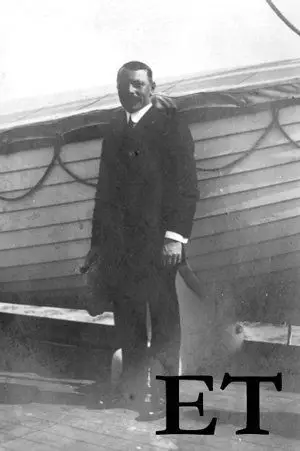
Pitman standing next to a lifeboat aboard the
Adriatic, in an undated photograph
(Encyclopedia Titanica).
Once the order was given to uncover the lifeboats by Captain Smith, First Officer Murdoch, with Pitman assisting, began uncovering the starboard lifeboats, starting with lifeboat no.7 and then moving on to no.5. The action between the two boats was close - Pitman describing that he "was clearing No.5 at the same time that No.7 was coming off. " (US Inquiry(25.))
At the US Inquiry Pitman mentions that "every man in the crew had his particular station on the Titanic" and that his was no.5 although "it was not necessary that I should go in No. 5 boat" but "that was my boat for boat and fire drill." (US Inquiry(25.))
However, at the British Inquiry he changed the number, stating that "No. 1 is my boat usually in case of emergency….that is in case of a man overboard, and things like that." There are boat list put up about the ship however "it is an understood thing the Third Officer looks after No.1 boat." He explains that he ended up at no.5 because " Mr. Murdoch ordered me there. " (British Inquiry(24.))
Pitman was not wearing a lifejacket. "Everyone I saw before I left the ship had a life belt on…There may have been a stray one of the crew without one.. I did not have one myself; I did not want it. " (US Inquiry(25.)) He also described that during the loading "there was not slighest suspicion of panic" (Taunton Courier, and Western Advertiser 2 August 1958).
Bruce Ismay and the Captain
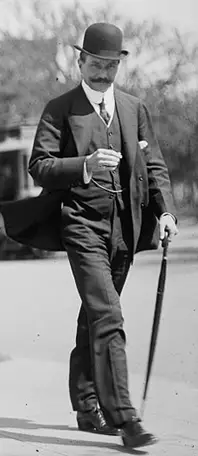
White Star Line chairman,
Bruce Ismay in 1912.
At this point while working on lifeboat number 5, a man in his "dressing gown and pajamas on" approaches and urges them to start loading the lifeboats immediately, but Pitman refuses to take his orders. Afterwards he realises that this man was Bruce Ismay, Chairman of the White Star Line. Pitman describes the moment at the US Inquiry that Ismay "remarked to me, 'You had better go ahead and get the women and children;' and I replied that I would await the commander's orders. I did not know it was Mr. Ismay at the time."(US Inquiry(25.))
On a separate occasion, Pitman described it thus: "In the act of clearing away this boat a man said to me, that was dressed in a dressing gown, with slippers on, he said to me very quietly, 'There is no time to waste' I thought he did not know anything about it at all. So we carried on our work in the usual way…. I did not know who it was then; I had never seen the man in my life before. So I continued on getting this boat uncovered and swinging out." Ismay replied to Pitman, " 'Very well', or something like that. It then dawned on me that it might be Mr. Ismay, judging by the description I had had given me. So I went along to the bridge and saw Capt. Smith, and I told him that I thought it was Mr. Ismay that wished me to get the boat away, with women and children in it. So he said, "Go ahead; carry on.” I came along and brought in my boat. I stood on it and said, "Come along, ladies." There was a big crowd. Mr. Ismay helped to get them along; assisted in every way. " (US Inquiry(25.))
Pitman explains his response to Ismay: "We take no orders from anybody except the commander." Ismay did not try again - according to Pitman "The next I saw of him was coming onto the Carpathia. " His conversation with Captain Smith was also the last he ever saw of the captain. (US Inquiry(25.))
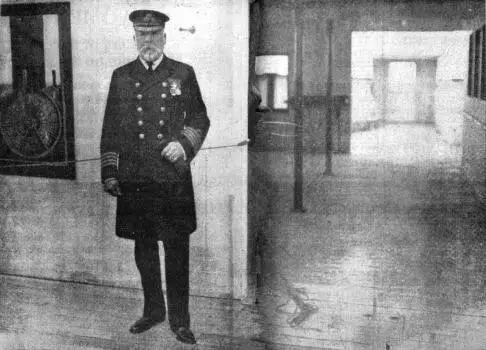
Captain Edward John Smith poses on Titanic's portside of the bridge on the morning of April 10th. Captain Smith told Pitman to "carry on" when he visited the bridge and told him what Ismay had said. (Click to enlarge)
At the British Inquiry he clarifies that "it would be about 12.20" when the lifeboat was being uncovered when Ismay "remarked to me as we were uncovering the boat, “There is no time to lose.” Of course, I did not know who he was then, and therefore did not take any notice." Lifeboat number 5 was then lowered level with the boat deck and "Mr. Ismay remarked to me to get it filled with women and children, to which I replied, 'I will await the Commander’s orders.' I then went to the bridge, and I saw Captain Smith, and I told him what Mr. Ismay had said. He said, 'Carry on.'" which effectively meant "Go ahead." (British Inquiry(24.))
Pitman was impressed with the new Welin davits on the Titanic: "It struck me at the time the easy way the boat went out, the great improvement the modern davits were on the old-fashioned davits. I had about five or six men there, and the boat was out in about two minutes... I thought what a jolly fine idea they were, because with the old-fashioned davits it would require about a dozen men to lift her, a dozen men at each end. I got her overboard all right, and lowered level with the rail." (US Inquiry(25.))
Loading commenced and Pitman "got the boat nearly full, and I shouted out for any more ladies... None were to be seen. So I allowed a few men to get into it. Then I jumped on the ship again. So Murdoch said, "You go in charge of this boat... he said, "You go away in this boat, old man, and hang around the after gangway." I did not like the idea of going away at all, because I thought I was better off on the ship."(25.)
In his alternative account at the British Inquiry Pitman then "simply stood in the boat and said, 'Come along, ladies,' and helped them in - Mr. Ismay helped to get them there." Pitman estimates that "between 30 and 40" ladies and two children were put in the boat. Pitman also took some male passengers, as he was struggling to find women, saying "I saw two standing by, but they would not leave." (British Inquiry(24.))
In the US Inquiry he states that he "filled my boat fairly easily" with "about 40... I should say about half a dozen men there; there would not have been so many men there, had there been any women around, but there were none." (US Inquiry(25.))
First officer Murdoch: "Goodbye and Good Luck"
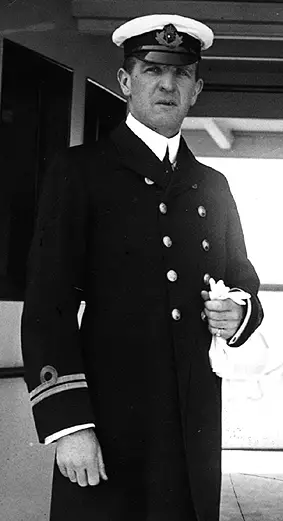
First Officer Murdoch on the bridge of the
R.M.S Olympic, 1911. Murdoch put Pitman
in charge of lifeboat no.5 and said
"Goodbye and good luck." (Click to enlarge)
According to Pitman the number to put in the lifeboat was decided by Murdoch, in addition to who took command. "I did not decide how many she should take. ..Mr. Murdoch, he came along just then... I jumped out of the boat then, ready to lower away, and he said, “You go in charge of this boat, and also look after the others, and stand by to come along the after gangway when hailed.” Mention of the gangway made Pitman think Murdoch would later hail them. "He said, “Keep handy to come to the after gangway.” Therefore, I understood he would hail us. " (British Inquiry(24.))
In the Senate Inquiry he had said: "Mr. Murdoch was there and he was the senior officer. It was for him to decide." But in Pitman's opinion, he thinks 40 is a safe load and that they should be loaded with a side ladder from a lower deck. He added: "I think 40 would be a very safe load. I do not think boats are ever intended to be filled from the rail" instead they should be filled "with a side ladder" from "about D or C; C deck, I should say." (US Inquiry(25.))
At the British Inquiry he was asked why he did not take 60 in the lifeboat, as it had a capacity for 65 and Pitman responded: "Simply because the people did not want to go - they thought they were safer on the ship." When asked if he thinks it would be safe to lower 60 people from a height of 70 feet he replied "I do not know what I might do if I was placed in that position" but that he "would do now, yes, because I have found out since you could lower 80 in them." (British Inquiry(24.))
Having been put in command of lifeboat no.5, rather touchingly, Murdoch says goodbye to Pitman. "He said, 'You go ahead in this boat, and hand [hang] around the after gangway.' He shook hands with me and said, 'Good-by; good luck;' and I said, "Lower away." (US Inquiry) As they said goodbye Pitman did not think the situation was serious. However, Pitman now realised that Murdoch "must have thought so." - that the situation was indeed serious. (British Inquiry(24.))
Senator Smith at the Senate Inquiry asked:
Senator SMITH. "When you shook hands with Murdoch and bade him good bye, did you ever expect to see him again?"
Mr. PITMAN. Certainly; I did.
Senator SMITH. Do you think, from his manner, he ever expected to see you again?
Mr. PITMAN. Apparently not. I expected to get back to the ship again, perhaps two or three hours afterwards.
Senator SMITH. But he, from his manner, did not expect that?
Mr. PITMAN. Apparently not. (US Inquiry(25.))
Pitman never saw Murdoch again after that.
This touching exchange was also observed by Mr Etches, a 43 year old first class bedroom steward from Southampton:
There were two firemen in the bow of the boat, Mr. Pitman was standing in the center on the deck waiting, and one steward was standing with myself at the forward fall. Olliver, the sailor, the quartermaster who been assisting, stepped back with myself into the crowd of gentlemen. Mr. Murdoch said to me: "Are you the steward appointed to this boat?" I said, "Yes, sir; No. 5 boat is mine." He said: “Then jump in and assist those men with the forward fall." I took my place. At the same moment Mr. Pitman called out: "Is there a sailor in the boat?" I looked around and I said: "No, sir." He said to this man Olliver, who was standing on the deck: "Are you a sailor?" He said: "Yes, sir." He said: "Take your place in this boat;" and he jumped in. Mr. Murdoch then stepped up and said, "Are you the officer going in this boat?"' He said: "Yes, sir." Then he said: “Take your place," held out his hand and shook hands and said, "Good-by and good luck." and he took his place and the order was given to lower the boat. (US Inquiry(25.))
In an account much later in life, Pitman said that when "the fourth boar from the port side[sic] was about to be lowered... the First Officer told Mr Pitman to get in. 'Three boats are already without an officer so you can be the first to leave' were the instructions he received." (Taunton Courier, and Western Advertiser 2 August 1958).
Lifeboat no.5 was lowered very soon after no.7 - Pitman described no.7 as having been lowered "two or three minutes previously. " The lowering took about " a minute and it may have been two minutes" and was accomplished by "two men… we had to go 70 feet." (US Inquiry). Pitman added "I should think it would be about 12.30 when No. 5 boat reached the water" (British Inquiry(24.))
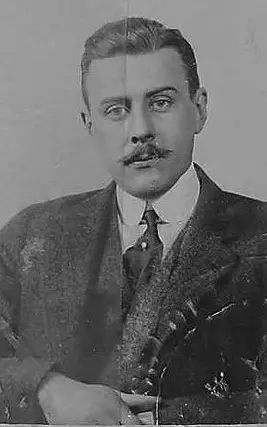
Mr George Harder, a first class businessman,
mentioned a "few scares" on the lowering
of lifeboat no.5 (Image: Geni.com)
But not everything went to plan with the lowering. According to a Mr George Harder, a first class businessman interviewed at the Senate Inquiry and passenger in lifeboat no.5 there were a "few scares":
That was the second boat to leave on the starboard side, as far as I could see. As we were being lowered, they lowered one side quicker than the other, but we finally reached the water safely, after a few scares. When we got down into the water, somebody said the plug was not in; so they fished around to see if that was in, and I guess it was in. Then, they could not get the boat detached from the tackle, so they fussed around there for a while, and finally they asked if anybody had a knife, and nobody seemed to have a knife. Finally, one of the passengers had a knife in his possession, and they cut some rope; what it was I do not know. They had two or three men on each side, letting out the rope, and they let out the rope on one side faster than the other. That caused the boat to assume this position going down [indicating] and we thought for a time that we were all going to be dumped out. We finally reached the water all right. Then the next job was to get the ropes at each end of the boat, the bow and the stern of the lifeboat, detached. I understand there was some new patented lever on there, some device that you pull, and that would let loose the whole thing. Whether they did not know that was there or not, I do not know; I presume they did not, because they did not seem to get it to work, and they finally had to resort to this knife…we started to pull away from the ship. We had, as I learned afterwards, about 42 people in the boat." (US Inquiry(25.))
Aft Gangway Doors
On reaching the water they "pulled away about 100 yards from the side of the ship" and "Lay on our oars" (British Inquiry(24.)). However, in both his US and British testimony Pitman said that Murdoch had referenced an aft "gangway" door, mentioning to "standby" or "hang around" and he would be hailed to return for more passengers. However it seems he never rowed in that direction. He was questioned at both inquiries on this point:
US Inquiry:
Senator SMITH. You say you got into this boat and it was lowered and you were told to go?
Mr. PITMAN. To stand by the after gangway.
Senator SMITH. Did you do it?
Mr. PITMAN. I did it as near as possible. I kept within a safe distance of the ship, if anything did happen.
Senator SMITH. You kept far enough away so that if anything happened you would not be involved in it? Is that the idea?
Mr. PITMAN. Exactly.
Senator SMITH. What did you expect to happen?
Mr. PITMAN. I thought she still had about three of the compartments and still would remain afloat.
Senator SMITH. And if she did not float and went down, were you expecting a suction that would draw the lifeboats down?
Mr. PITMAN. Well, yes; I thought we might get into a bit of a wash.
Senator SMITH. And that you were seeking to avoid?
Mr. PITMAN. Seeking to avoid; yes...
Senator SMITH. When you went around the after part of the ship?
Mr. PITMAN. After? I did not go around the stern.
Senator SMITH. You did not go back there?
Mr. PITMAN. No.
Senator SMITH. What did Murdoch tell you to go back there for? Do you know?
Mr. PITMAN. Just to be handy, I suppose.
Senator SMITH. To be handy to pickup?
Mr. PITMAN. To pick up again; to pick the boat up again. (US Inquiry(25.))
British Inquiry:
15025. On reaching the water what was done with that boat?
- We pulled away about 100 yards from the side of the ship.
15026. And then?
- Lay on our oars.
15027. Did you take her in the direction of the gangway, in case Mr. Murdoch might hail you and order you back?
- Well, we dropped astern a little.
15028. That would be somewhere in the direction towards the gangway?
- Yes.
15029. (The Commissioner.) Just put your finger on the gangway you are talking about. (The Witness pointed it out on the model.) That is right aft?
- Yes, he said the after gangway.
15030. (Mr. Butler Aspinall.) Before you left the ship had you heard any order given about lowering the gangway or opening the gangway door?
- No, that was the first I knew of it.
15031. After you were in the boat and had rowed out this 100 yards somewhat astern did you notice whether the gangway door was open or not?
- I do not think it was.(British Inquiry(24.))
So it seems he rowed slightly in the direction of the stern, but noticed the aft gangway door was not open. Believing that Titanic would "still would remain afloat" he did not see any necessity in returning at that point.
At the US Inquiry he was asked by Senator Fletcher:
Senator FLETCHER. What course did you take after your boat was lowered into the water? Did you go to the stern of the Titanic, to the bow, or off from her?
Mr. PITMAN. Just rowed off from her, that way [indicating].
Senator FLETCHER. Which way?
Mr. PITMAN. To the north.
Senator FLETCHER. To the north how far?
Mr. PITMAN. It may have been three or four hundred yards.(US Inquiry(25.))
At another time in the US Inquiry he described that they "cast the boat off and pulled away some safe distance from the ship. It was not for an hour that I realized she would go - an hour after we got into the water. I quite thought we would have to return to the ship again, perhaps at daylight. My idea was that if any wind sprang up we should drift away from the ship and have a job to get back again."
According to Alfred Shiers, a fireman in boat no.5 and questioned at the British Inquiry, he "had orders to pull round the front of the boat. " (British Inquiry(24.))
Occupants and contents of Lifeboat No.5
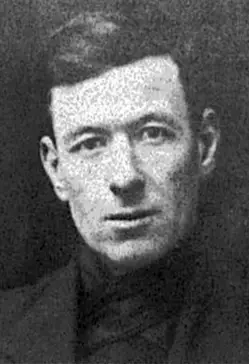
Fireman Alfred Shiers in lifeboat no.5
said they had "orders to pull round the
front" of Titanic.
According to Pitman he had "five of the crew, and there may have been five or six passengers - male passengers" with the rest "Women and children... know them by name, now; I did not know them previously." He originally thought he had only four crew - " I did not discover I had five until some time on the Carpathia, during the trip on the Carpathia…. There were one sailor, two firemen, two stewards, and myself. No, I have not got their names…. I had about 40 passengers." (US Inquiry(25.))
Pitman testified that he "had no trouble whatever with my boat. The women all behaved admirably." and that while no women pulled on the oars or handled the tiller " they wanted to…to keep themselves warm" as it was "chilly…it may have been 40 - 35 to 40 [Fahrenheit]." (2 - 4 degrees Celsius) (US Inquiry(25.))
The lifeboat had "biscuits and water in it." although neither was used. He knows they were in the lifeboat as "they were put there in Southampton; and we also went through all the boats on the Carpathia…. The boats had bread and water… I did not have a light in my boat" although several other lifeboats did (US Inquiry(25.))
At the British Inquiry he added that there was no lamp or compass - although a compass "would be absolutely useless to me." Water was kept on the boat "in two breakers" and biscuits in "a tank in the stern of the boat. "(British Inquiry(24.))
Rockets and a light on the horizon
Pitman described seeing Titanic's distress rockets being fired shortly after they left the Titanic: "They were fired from the rail. They make a report while leaving the rail, and also an explosion in the air, and they throw stars, of course, in the air… Various colours. .. It may have been a dozen or it may have been more." (US Inquiry(25.))
He also spotted a light on the horizon: "I saw one white light... Away on the horizon. We could not make anything out of it... About half past 1… It was to the westward". He describes it as being "Right ahead" on Titanic's course. " I just saw a white light, and that is all. I said, "There is no use in pulling toward it until we know what it is." We saw the light, but I said, "What is the use of pulling to it?" It might have been one of our own boats with a white light on it. " Pitman could not be certain it was a steamer or sailing vessel "because there was no motion in it, no movement…It may have been 1 o'clock or half past 1. One of my men called my attention to the white light over there… It may have been 3 miles." (US Inquiry(25.))
Pitman later confirmed the mysterious light on the horizon at the British Inquiry, saying that it was an "excellent night" in terms of visibility long distance: "I saw a white light which I took to be the stern light of a sailing ship…I thought it was about five miles… it may have been less." (British Inquiry(24.))
Joining lifeboat no.7
Prior to Titanic sinking, Pitman comes alongside lifeboat no.7 that had been launched "two or three minutes previously" and "had it made fast to me. As there was no officer in the boat I said, 'Look here, make fast to me and we will hang on until daylight, as it is smooth water, and at daylight we will set our sails, and we will be more likely to be picked up if we are together than if one of us is over there and one over here.'" They were attached "by a rope - a painter... We were alongside, close alongside of each other for some time; side by side for some time" but Pitman could not see how many crew were in no.7 as " it was too dark." He then transferred four people to balance up the load: "We did count them, but I forget how many were really in that boat. I transferred a woman and child and two men from my boat into that boat." (US Inquiry(25.))
Pitman explains that his "idea of lashing together was to keep together, so that if nothing hove in sight before daylight we could steady ourselves and cause a far bigger show than one boat only and with far more hope of being picked up. That was my idea in hanging together. " The two lifeboats stayed together "from 1 to half past 2... It may have been an hour and it may have been two. " but "had cast off before the Carpathia came in sight. " (US Inquiry(25.))
First class passenger George Harder also noted the transfer between no.5 and no.7 stating "We rowed out there some distance from the ship. How far it was, I do not know. It may have been as far as a quarter of a mile, and it may have been one-eighth of a mile. At any rate, we were afraid of the suction. So the passengers said, "Let us row out a little farther." So they rowed out farther, perhaps about a half a mile; it may have been three-quarters of a mile. There we waited, and after waiting around a while, there was this other boat that came alongside, that Pitman hailed alongside; and that was either boat No. 7 or boat No. 5, I do not know which, in which Mr. and Mrs. Bishop were. We tied alongside of that, and they had 29 people in their boat, and we counted the number of people in our boat; and at that time we only counted, I think it was, 36. So we gave them four or five of our people in order to make it even, as we were kind of crowded."(US Inquiry(25.))
Watching Titanic Sink
According to Pitman Titanic "remained stationary from the time I left the ship till she disappeared" and did not alter her heading, but was noticeably down by the head. Pitman "did not give up hopes until I saw the last line of lights on the forecastle head disappear... watched the different lines of lights disappear." (British Inquiry(24.))
In later life he described how as "the lifeboat, with its 40 passengers, drifted further away from the stricken liner Mr. Pitman himself still did not realise that the Titanic was going to sink. 'I had no idea she was doomed,' he said. 'I thought she would take in a certain amount of water, yet manage to stay afloat. But the damage was too much.' The thousands of lights on board illuminated the Titanic in her dsperate fight to remain afloat until just ten minutes before the actual sinking. This Mr. Pitman watched from the lifeboat about half a mile away, and the next few minutes were the most horrifying he has ever experienced."(Taunton Courier, and Western Advertiser 2 August 1958).
Pitman could not see the people on the decks from that distance (US Inquiry) and places the distance from Titanic she sank at "about 200 yards away" and that they were on her "starboard quarter" which he said was about abreast of the mainmast (British Inquiry(24.)).
At the US Inquiry he described the sinking: "Judging by what I could see from a distance, she gradually disappeared until the forecastle head was submerged to the bridge. Then she turned right on end and went down perpendicularly... She went straight." When asked by Senator Smith "Did she seem to be broken in two?" Pitman replied "Oh, no." (US Inquiry(25.))
According to first class passenger and occupant of lifeboat no.5, Mrs Eleanor Genevieve Cassebeer noticed, as Titanic made the final plunge, Pitman take off his officer's hat and place it to his chest.
Pitman knows the exact time Titanic sank, stating: "2.20 exactly, ship's time. I took my watch out at the time she disappeared, and I said, 'It is 2.20,' and the passengers around me heard it..2.20 a. m., the 15th of April. (US Inquiry(25.))
Pitman also heard "four reports... they sounded like the reports of a big gun in the distance... I assumed it was bulkheads going, myself." But he did not think the reports were caused by a boiler explosion, explaining: "I have my doubts about that. I do not see why the boilers should burst because there was no steam there. They should have been stopped about two hours and a half. The fires had not been fed, so there was very little steam there." He added that he heard the reports when Titanic was completely submerged in the water. (US Inquiry) At the British Inquiry he estimated the "four reports" were "boilers leaving the bedplates and crashing through the bulkheads." (British Inquiry(24.))
Although hearing the "four reports" Pitman was of the opinion that the ship did not break in two. At the Senate Inquiry he was asked whether he thought "that is true that she broke in two in that way bringing her afterpart level with the water again and then went down in that way. Did she crack in the middle?" To which he answered: "I do not think so. If the afterpart had broken off it would have remained afloat." Interesingly though, there were two other occupants of lifeboat 5 that did see Titanic split in two - QM Olliver later reported "she broke forward, and the afterpart righted itself and made another plunge and went right down" While Samuel Etches said "she seemed to raise once as though she was going to take a violent dive, but sort of checked, as though she had scooped the water up and had levelled herself."
Sometime later, Pitman wrote a handwritten account of the disaster which has as yet been unpublished (more information here). However this excerpt was read out during an episode of the BBC's Antiques Roadshow:
"At 2.20am, 15th of April 1912 (by my watch) all lights on board disappeared. In a few moments the vessel's stern was in the air. The next moment she was gone. Within the next ten minutes or so it was truly heartbreaking to hear the cries coming from the hundreds of drowning people. And we could do nothing about it. As my boat was full."
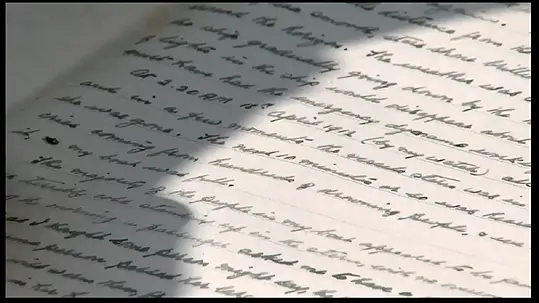
Pitman writes that it was "truly heartbreaking to hear the cries coming from the hundreds of drowning people." (Click image to enlarge)
After Titanic had disappeared from sight, Pitman testified that he did not see any people in the water but did her their cries of distress - "Crying, shouting, moaning…From the water, after the ship disappeared; no noises before." (US Inquiry(25.)).
However when pushed by Senator Smith to describe the sounds in the water, a tense line of questioning resulted:
Senator SMITH. How many of these cries were there? Was it a chorus, or was it -
Mr. PITMAN. I would rather you did not speak about that.
Senator SMITH. I would like to know how you were impressed by it.
Mr. PITMAN. Well, I can not very well describe it. I would rather you would not speak of it.
Senator SMITH. I realize that it is not a pleasant theme, and yet I would like to know whether these cries were general and in chorus, or desultory and occasional?
Mr. PITMAN. There was a continual moan for about an hour.
Senator SMITH. And you lay in the vicinity of that scene for about an hour?
Mr. PITMAN. Oh, yes; we were in the vicinity of the wreck the whole time.
Senator SMITH. And drifted or lay on your oars during that time?
Mr. PITMAN. We drifted toward daylight, as a little breeze sprang up.
Senator SMITH. Did this anguish or these cries of distress die away?
Mr. PITMAN. Yes; they died away gradually.
Senator SMITH. Did they continue during most of the hour?
Mr. PITMAN. Oh, yes; I think so. It may have been a shorter time. Of course I did not watch every five minutes -
Senator SMITH. I understand that, and I am not trying to ask about a question of five minutes. Is that all you care to say?
Mr. PITMAN. I would rather that you would have left that out altogether. (US Inquiry(25.))
The screams did not last long - according to his later recollections: "The screams of more than 1,000 people still onboard as the liner made its final plunge to the sea bed, seemed to last an age, but in actual fact, the waters were very quickly silent again."(Taunton Courier, and Western Advertiser 2 August 1958).
"We just simply lay there doing nothing"
It seems that Pitman initially wanted to return to help. At the US Inquiry he stated that they "may have been three of four hundred yards away; four or five hundred yards away... As soon as she disappeared I said, 'Now, men, we will pull toward the wreck.' Everyone in my boat said it was a mad idea, because we had far better save what few we had in my boat than go back to the scene of the wreck and be swamped by the crowds that were there. " (US Inquiry(25.))
Pitman later explained that "I told my men to get their oars out, and pull toward the wreck - the scene of the wreck" and said "we may be able to pick up a few more" but he faced resistance from "the whole crowd in my boat. A great number of them did…I could not discriminate whether women or men. They said it was rather a mad idea." Not one woman passenger urged Pitman to return (US Inquiry(25.))
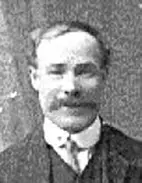
Quartermaster Olliver
said "the women
passengers implored
[Pitman] not to go" back.
However Senator Smith picked up on the fact that Pitman had ordered the "men with the oars" and since Pitman was "in command. They ought to have obeyed your orders?...They did not, if you told them to pull toward the ship." Pitman responded by saying "They commenced pulling toward the ship, and the passengers in my boat said it was a mad idea on my part to pull back to the ship, because if I did, we should be swamped with the crowd that was in the water, and it would add another 40 to the list of drowned, and I decided I would not pull back."(25.)
In response to the passengers Pitman said they "simply took our oars in and lay quiet…We may have drifted along. We just simply lay there doing nothing." Pitman also stated the reason for not returning: "Well, there was such a mass of people in the water we should have been swamped... I had too many in the boat to go back to the wreck. " (British Inquiry (24.))
There are also several collaborating accounts from those in lifeboat no.5 as to Pitman's order to return being changed in favour of the passengers. Quartermaster Alfred Olliver at the US Inquiry said they were "about 300 yards" away and he heard Pitman's order to go back to the ship but "the women passengers implored him not to go, because they reckoned it was not safe." Pitman then countermanded the order and "he did not go…they very nearly all objected" to returning. Olliver also agrees it would not have been safe to return - "I reckon it would have been endangering the lives of the people we had in the boat already." (US Inquiry (25.))
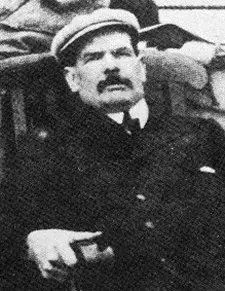
First class bedroom steward Henry
Etches also mentioned women
passengers in lifeboat no.5
appealing to 'not go back'
First class bedroom steward Henry Etches also agrees stating: "We waited a few minutes after she had gone down. There was no inrush of water, or anything. Mr. Pitman then said to pull back to the scene of the wreck. The ladies started calling out. Two ladies sitting in front where I was pulling, said, 'Appeal to the officer not to go back. Why should we lose all of our lives in a useless attempt to save those from the ship?' I said I had no power; an officer was in charge of the boat, and he must use his discretion... When we had gone away from the ship we had 42, including the child. " (US Inquiry(25.))
When fireman in boat no.5, Alfred Shiers, was asked at the British Inquiry "Did you hear cries?" he replied "The women in the boat stopped that, and the officer who was in charge of the boat - Officer Pitman told us to pull to the boat." Shiers described Pitman as being "in the stern" and the women in lifeboat 5 said "Do not go back" and "we were pulling away and he told us to lay on our oars." (British Inquiry(24.))
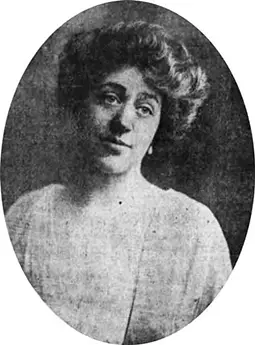
First class passenger, Mrs Cassebeer,
reported that Pitman ordered his men
"three times" to return to save people
drowning.
A woman occupant came to the defence of Pitman. On Monday 29th April 1912, the Lincoln Daily News reported: "Mrs. H.A. Cassebeer, jr, a Titanic survivor who says she is going to Washington to tell her story to the senate committee. 'I was in Pittman's [sic] boat and I am going to tell the senate committee that he wanted to turn back, but the passengers seized the oars and refused to let him do so.'" In a parallel account, the Binghamton Press printed a statement from her:
"There was absolutely no panic. The discipline was excellent. I was in the boat commanded by Third Officer H. J. Pitman. There were 37 people in the boat, five of them being seamen. The boat could not hold any more at the time, as it would have been foolhardy to attempt to overload it, inasmuch as it would have buckled and broken in two from the extra weight the moment it was swung from the davits.
We saw the Titanic when it made its final plunge. The lights were burning until the very last moment and it was a spectacular as well as awesome sight. After the Titanic had sunk there were thousands of people struggling in the water crying piteously for help. Three times Officer Pitman ordered his men to turn about so that he could pick up some of them, but each time they were prevented from doing so by some of the passengers in the lifeboat who called upon the seamen frantically to go ahead and when they grasped the oars and interfered with the proper handling of the boat so that the seamen were finally forced to give up their efforts of turning back to rescue any of the unfortunates." (Binghamton Press, Monday 29th April 1912)
Allegedly, in later life Pitman admitted to bearing the burden of a bad conscience for his failure to take the lifeboat to the rescue of those dying in the water that night.
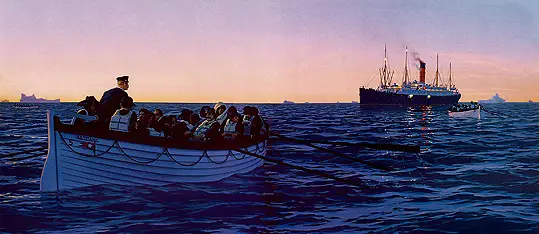
Titanic visual historian and painter Ken Marschall has painted Third officer Pitman in lifeboat 5 approaching the Carpathia. (Click image to enlarge)
Lifeboat no.5 drifted on her oars in an area in which "there were numerous bergs around me, maybe half a dozen; but I was not sufficiently interested to count them… Some may have been 100 feet or 150 feet." They had not been rowing but instead "drifting with a little wind…we got a little wind at 4 o'clock, a little breeze at 4 o'clock. " (US Inquiry(25.))
They finally spotted the lights of the Carpathia -"We saw her lights about half past 3, as near as I can recollect…we waited until we were certain it was a steamer, and then we pulled toward her…We could see the masthead light over 5 miles on a clear night…I waited to make certain it was a steamer, until I could see both masthead lights…that must have been about 4 o'clock. ..It was just breaking day." (US Inquiry(25.))
They rowed toward the Capathia and once there, Pitman helped transfer passengers from lifeboat no.5 onto the Carpathia.
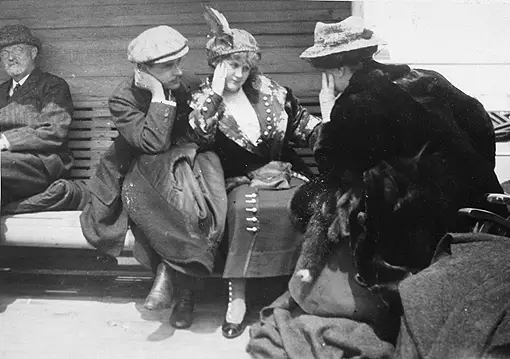
Lifeboat no.5 occupants George and Dorothy Harder talking with Sallie Beckwith
on the Carpathia. (Click image to enlarge)
One of the most iconic photographs of passengers aboard the Carpathia, taken by 19 year old Canadian Bernice Palmer with her Kodak Box Brownie camera, is of a honeymoon couple, George and Dorothy Harder talking with fellow passenger Sallie Beckwith. All three had just been rescued in Pitman's lifeboat no.5. It was not the only romantic story to originate from lifeboat no.5. Famous No.5 passengers include Karl Behr, American tennis star and banker, who was pursuing fellow first class passenger and no.5 occupant Helen Newsom. After the rescue, several newspapers reported that Behr had proposed to Miss Newsom in the lifeboat. They married on March 1, 1913 in New York.
Stamp Collection Lost with Titanic
Pitman lost all his personal belongings in the Titanic disaster - including a precious stamp collection:
In the disaster he lost, all his personal belongings, including a comprehensive collection of stamps, and the only thing he still retains from that fatal night is a whistle which had to be carried by all navigational officers... He says that if there had been sufficient life-saving equipment and if there had been a breeze that night off the Newfoundland coast the disaster might not have happened.(Central Somerset Gazette, 27th August 1954)